The real Joburg in 6 powerful photos
- Tanya Zack
From butchers to hawkers, and shelters to miners, this book reveals the informal economy and texture of the city.
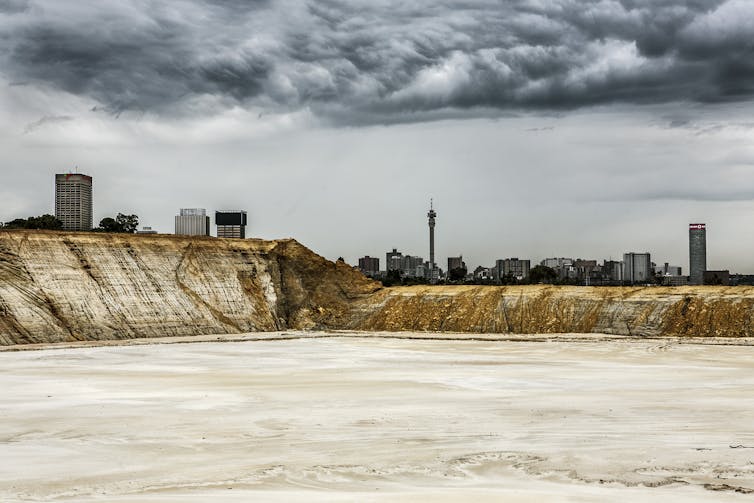
Wake Up, This is Joburg is a collaboration between photographer Mark Lewis and urban planner and writer Tanya Zack. Striking images and beautiful texts follow 10 stories the team discovered in urban Johannesburg, South Africa. Each chapter captures many overlapping stories that come together around a character, a place or an activity. The book is an ethnographic portrait of one of Africa’s most vibrant and intriguing cities. We asked for the stories behind six of its images.
1. Chopping s'kop
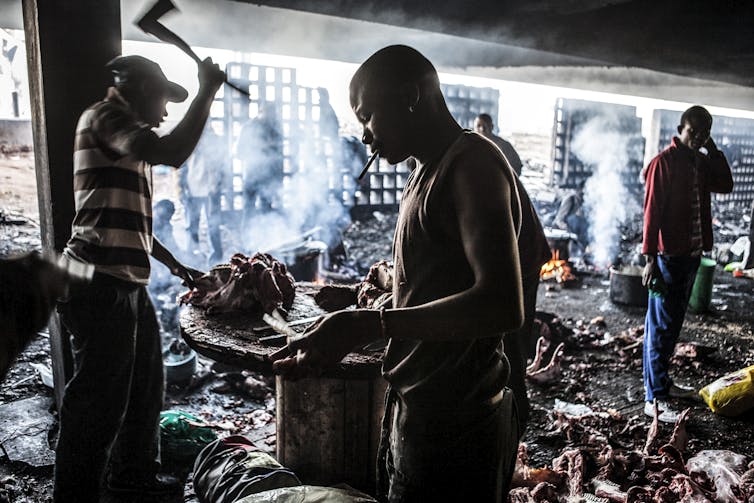
The most marginal of the activities and spaces the stories explore is the informal butchers who chop up cow heads in a disused parking garage in the heart of the inner city. The condemned building is next to formal structures and within view of banking head offices.
The cow heads, or s'kop, are bought for R10 (US$0.55) each by nearby formal butcheries and delivered to them in shopping trolleys. Every part is sold in this marginal economy. Flesh is stripped off the skull, bones are taken to be crushed for bone meal, and skins enter a unique processing operation in invisible spaces in the city and transformed into an edible form.
Andile Nkomo from KwaZulu-Natal province is the most muscular of the six butchers on the day we first visit and, we soon discover, the most active. But he admits his output varies. On mornings after he’s worked as a bouncer at a Hillbrow nightclub, he is not in peak form. “On a good day I chop 60 heads,” he says as he slams his axe repeatedly into skulls on the wooden industrial cable spool that is the butchers’ block.
2. Breakfast on the run
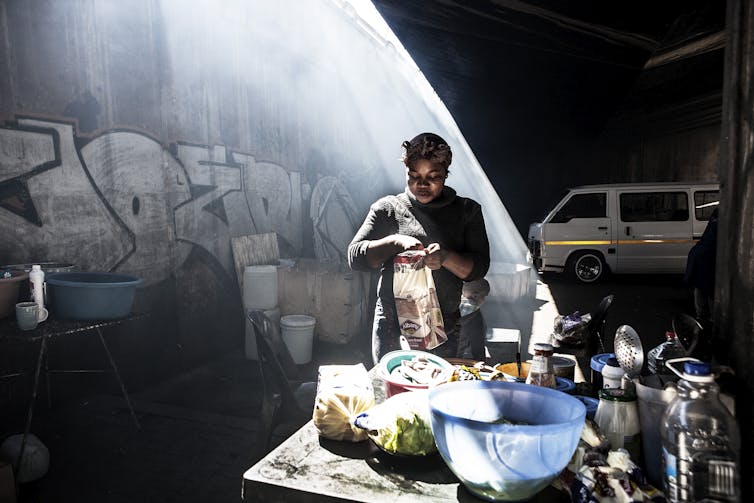
Competition within the informal economy is tight. At the minibus taxi binding point Zola, micro-entrepreneurs offer barber services and sell food, snacks, socks, window wipers, mobile phone accessories and bumper stickers.
Stallholder Monica Chauke, originally from Limpopo province, is unperturbed by the competition for the appetites of the 600 taxi drivers. She knows that by midday she will have sold out of her unique offering and made her US$16 daily profit. Her niche is simple: she serves only breakfast. But there’s nothing simple about it. Monica has, over four years, worked out who likes what and caters to the specific tastes of her customers. This means making six egg-and-tomato, three cheese-and-tomato and four chicken-mayonnaise sandwiches, as well as six cheeseburgers each morning. And baking scones, frying balls of dough called vetkoek, preparing a soup of beans and bones and making a meat stew. Her commitment to providing variety no matter how small the quantity has earned her loyal customers.
Monica wakes at 2am to prepare and package the food and the equipment she brings here. “I want to work here because no one is controlling me. It’s for myself,” she says. “My boyfriend brings and fetches me each day.” In his car? “No, in my car. He drives it.”
3. Bed room
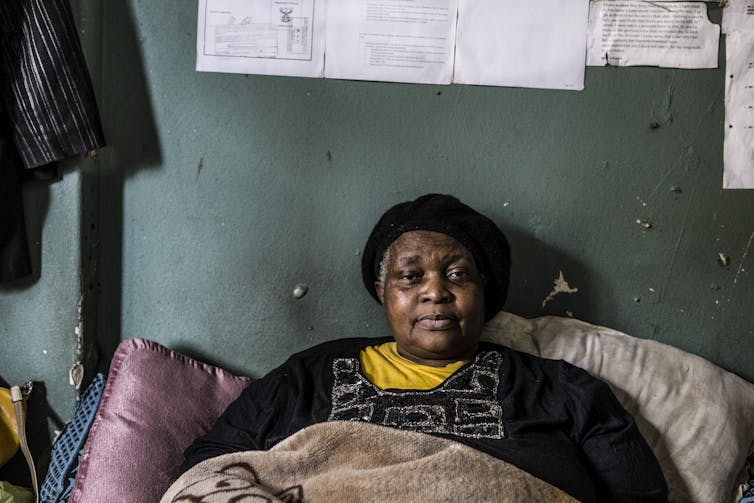
From her bed in a small Hillbrow apartment, Birthial Gxaleka – a nurse from the Eastern Cape province – runs a non-governmental organisation and shelter. Her tenants share her one-bedroomed space, sleeping and living on a large raft of beds that leaves only a narrow corridor of standing room. At any one time, there are up to 34 residents, because it is rare for Birthial to turn anyone away.
Each person wants to make their way in the world: find a job, reconnect with lost family, get access to healthcare or simply secure a decent place to sleep.
In the inner city’s high-rise flatland, at human densities 10 times greater than Hong Kong, people find ways to get on with things.
4. Under the city

“This park is closed until further notice. Entry strictly forbidden.” This is the sign at the entrance to the place where the metal that would make this the wealthiest gold-producing city on the planet was first discovered. It does not deter anyone. Least of all those with the grit to seek a living or a fortune in the abandoned mine shafts of the Witwatersrand reef.
Known as zama zamas (those who keep trying), they work the dumps and cavities underneath the city. We visit the Langlaagte belt, which contains more unmined gold than any other vein in Johannesburg’s gold reef. They call it FNB (First National Bank). Here zama zamas of all ages, backgrounds and ethnicity use the same ancient pick and shovel method to wrestle with the rock face.
It is Nandos Simao, leaning in elegant repose against the remains of a concrete wall, who catches our attention. The 23-year-old Mozambican lives in the Orange Farm informal settlement with two fellow miners, his cousins. The youngest is 17.
There are many ways to die underground. But it’s a livelihood on which whole settlements depend. Indeed, MaLetsatsi Mamogele is digging for gold under her shack in Fleurhof, a working class suburb west of Johannesburg.
5. Good riddance
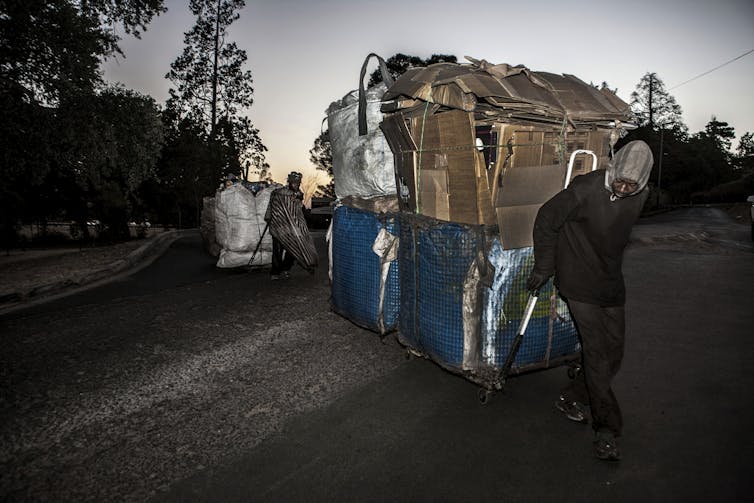
Young Mozambican Lucas Ngwenya and his two South African friends have lined up. It’s 6am. There’s a cold wind blowing on this open piece of land suspended between the private estate of the Oppenheimers, South Africa’s wealthiest family, and the headquarters of Hollard Insurance. It’s 4℃ as the men begin their 5km trip to the recycling depot in Newtown to sell the materials they’ve collected from suburban dustbins over a fortnight. It will take two-and-a-half hours to drag their gargantuan loads.
Lucas seemingly has the lightest burden, but points out that the cardboard, which occupies double the capacity of his plastic quilted bag, will weigh in at over 150kg. The plastic bottles and white paper will bring this to 265kg. His body mass is 61kg. When he arrives at the depot he will be asked for R10 “for cool drink” as he cashes in his load. Because, the cashier says, she has been generous with the amounts she has recorded.
6. Tony dreams in yellow and blue
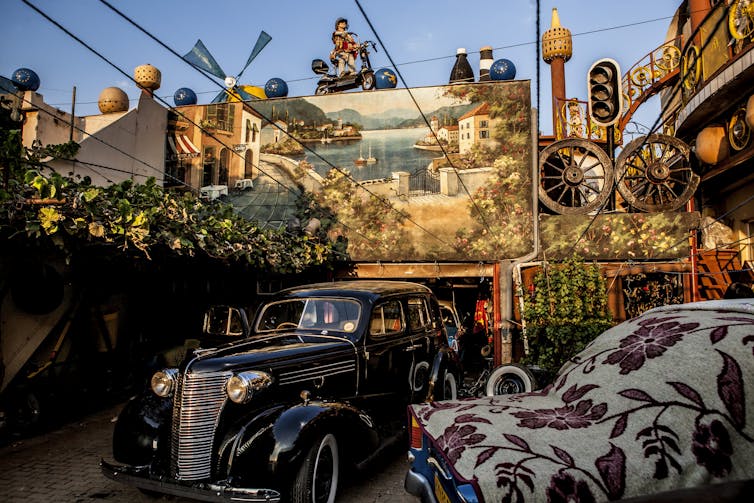
Tony Martins built his first house in Madeira, Portugal, in his early 20s – because his wife’s mother “wouldn’t let me take her until I had a house to live in”. Some 30 years later he’s transforming his modest home in Johannesburg’s “old south” into a veritable castle – using objects he finds at waste dumps. Tony is an outsider artist.
He admits he cannot stop himself. “I sleep for two or three hours, and then I wake and think what else I can do. Then I have to do them in the day.”
The house is a wonder of lights and murals, of manikins in domes and on motorbikes on the roof, of a traffic light and windmill and of multiple staircases with balustrades fashioned from found tennis racquets and bicycle wheels. It is the sort of delightful outcome of a city not intervening in the authentic expression and private worlds that are possible in urban spaces where excess, waste and cosmopolitanism collide.
The book is available from Duke University Press![]()
Tanya Zack, Visiting researcher, University of the Witwatersrand. This article is republished from The Conversation under a Creative Commons license. Read the original article.

